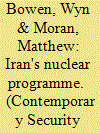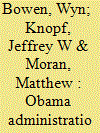|
|
|
Sort Order |
|
|
|
Items / Page
|
|
|
|
|
|
|
| Srl | Item |
| 1 |
ID:
108181


|
|
|
| 2 |
ID:
191976


|
|
|
|
|
| Summary/Abstract |
Over the past two decades, the international community has devoted considerable attention to the human dimension of nuclear security. This trend is part of a more holistic approach to securing nuclear facilities, grounded in the concept of culture, that moves beyond the traditional focus of physical-protection measures. But what explains this shift and what does it entail? This article begins by demonstrating, through a series of real-life case studies, the potential for human factors to undermine nuclear-security systems. It then considers the rise and consolidation of “culture” as a concept used to better understand and organize international efforts to strengthen nuclear security. Nuclear-security culture is then explored in practice, drawing on a review of relevant initiatives as well as empirical research conducted by the authors at several UK nuclear sites. A number of likely challenges for developing an effective nuclear-security culture at the operational level are discussed, as is the value of the culture-focused guidance developed by the International Atomic Energy Agency. The article concludes that while nuclear-security culture has been widely promoted at the international level, there exists considerable scope for new initiatives to further strengthen engagement at the working level of industry.
|
|
|
|
|
|
|
|
|
|
|
|
|
|
|
|
| 3 |
ID:
164197


|
|
|
|
|
| Summary/Abstract |
In the age of ‘Big Data’, the potential value of open-source information for intelligence-related purposes is widely recognised. Of late, progress in this space has increasingly become associated with software that can expand our ability to gather, filter, interrelate and manipulate data through automated processes. The trend towards automation is both innovative and necessary. However, techno-centric efforts to replace human analysts with finely crafted algorithms across the board, from collection to synthesis and analysis of information, risk limiting the potential of OSINT rather than increasing its scope and impact. Effective OSINT systems must be carefully designed to facilitate complementarity, exploit the strengths, and mitigate the weaknesses of both human analysts and software solutions, obtaining the best contribution from both. Drawing on insights from the field of cognitive engineering, this article considers at a conceptual level how this might be achieved.
|
|
|
|
|
|
|
|
|
|
|
|
|
|
|
|
| 4 |
ID:
114687


|
|
|
|
|
| Publication |
2012.
|
| Summary/Abstract |
In February 2012, Iran announced its willingness to resume negotiations with the Western powers. This statement followed in the wake of a damning report by the International Atomic Energy Agency (IAEA) Board of Governors and the imposition of additional sanctions by the international community on an Iranian economy already under pressure. Tehran's announcement also coincided with increased speculation regarding an Israeli military strike on Iranian nuclear facilities. At the same time, however, this seemingly positive step appeared to be undermined by Iran's concomitant announcement that "huge" technical progress has been made on Iran's nuclear programme. This article will explore the significance of the recent political, diplomatic and technical developments in the Iranian nuclear affair and situate them in the broader context of Tehran's nuclear strategy. The analysis will assess the potential for this latest phase in the Iranian nuclear crisis to reverse Iran's current trajectory and initiate a rapprochement between Iran and Western powers.
|
|
|
|
|
|
|
|
|
|
|
|
|
|
|
|
| 5 |
ID:
129668


|
|
|
|
|
| Publication |
2014.
|
| Summary/Abstract |
This article examines Iranian proliferation behaviour through the lens of nuclear hedging. Defined as 'nuclear latency with intent', hedging is an area of proliferation behaviour that has not been fully explored. The Iranian case presents an outstanding example of the questions and types of evidence required to judge whether a nuclear programme is engaged in a hedging strategy. By examining a nuclear programme from three distinct angles - technical, narrative and diplomatic - key elements of strategic hedging can be identified. Applied to Iran, evidence supports a diagnosis of hedging. But this assessment is further complicated by Iran's domestic political context, which has engendered an approach that is as much 'hedging by default' as it is 'hedging by design'. This approach allows Tehran to reconcile restraint with domestic consensus on nuclear advancement. In this regard, our analysis shows that international exposure of Iran's undeclared nuclear activities had an enormous impact on the direction of Iran's nuclear programme, placing important constraints on Iran's nuclear progress. The article argues that any solution to the Iranian nuclear challenge must be based on realistic goals. The international community should focus on containing Iranian advancements rather than rollback, with a view to restricting hedging to a low level of latency.
|
|
|
|
|
|
|
|
|
|
|
|
|
|
|
|
| 6 |
ID:
123038


|
|
|
|
|
| Publication |
2013.
|
| Summary/Abstract |
In the latter part of the 20th century, much academic attention has been devoted to the patterns of change in international power relations. From the legacy of imperialism to the end of the Cold War and the rise of American unipolarity, far-reaching geopolitical shifts have dramatically impacted the structure and composition of the international arena. Countries find themselves at the confluence of far-reaching developments such as the rise of supranational organisations, changes in migratory flux and the redistribution of power and influence between nation-states. This fluid and rapidly-changing international environment has provoked profound changes in how nation-states are perceived and perceive themselves. Questions of status and prestige have taken on new significance as shifts in traditional international power relations have challenged the historically-rooted narratives around which national identities are constructed. But how have nation-states responded to these global changes? What has been the effect on national identities? This article will explore the extent to which nuclear weapons policy in France and Russia reflects an attempt to reconcile narratives of national greatness with a gradual loss of influence and status in the international community.
|
|
|
|
|
|
|
|
|
|
|
|
|
|
|
|
| 7 |
ID:
140265


|
|
|
|
|
| Summary/Abstract |
For the past decade, much attention has been devoted to the potential consequences of a nuclear-armed Iran. Yet the binary ‘acquisition/restraint’ lens through which the Iranian nuclear issue is frequently viewed is limiting. There is now much evidence to suggest that Iran is engaged in a strategy based on nuclear hedging, rather than an outright pursuit of the bomb. This does not change the need to contain Tehran's proliferation potential, yet it does add another layer of complexity to the challenge. Iran will retain a low level of latency whatever the final outcome of longstanding diplomatic efforts to constrain the scope and pace of its nuclear efforts. This article will explore the implications of Iranian nuclear hedging and consider how regional rivals might interpret and respond to Tehran's nuclear strategy. On a larger scale, the article will explore the potential impact of the international community's approach to the Iranian case—implicitly recognizing, even giving legitimacy to, hedging—both in terms of the future of the Nuclear Non-Proliferation Treaty (NPT) and the ability of the international community to limit the negative effects of this form of proliferation behaviour.
|
|
|
|
|
|
|
|
|
|
|
|
|
|
|
|
| 8 |
ID:
117713


|
|
|
|
|
| Publication |
2012.
|
| Summary/Abstract |
The past year has seen a steady rise in tensions with regard to Iran's nuclear programme. Iran's economy is being crippled by far-ranging sanctions and the threat of an Israeli attack on Iranian nuclear facilities looms large on the horizon. Yet the country's nuclear programme marches on, stoking fears that Iran may indeed be seeking to cross the nuclear weapons threshold. In this context, it is timely to consider how key regional players would respond to a nuclear-armed Iran. Many argue that an Iranian bomb would prompt a proliferation cascade in the Middle East. However, a closer examination of the drivers for key regional players shows that this is not necessarily the case. There is a range of non-proliferation tools that could be applied by the West and others to offset this risk.
|
|
|
|
|
|
|
|
|
|
|
|
|
|
|
|
| 9 |
ID:
177064


|
|
|
|
|
| Summary/Abstract |
This article examines responses to the Syrian government’s possession and eventual use of chemical weapons (CW) in that country’s civil war from 2012 to 2013. During this time, the United States and other outside powers applied coercive strategies, in both deterrent and compellent modes. Outcomes varied: compellence in the form of coercive diplomacy achieved a partial success, getting Syria to give up much of its chemical stockpile, but there were multiple deterrence failures, culminating in a large-scale sarin gas attack in August 2013. We examine this record to draw lessons about factors associated with the effectiveness of coercion. Our analysis draws on insights from existing research on both deterrence and coercive diplomacy to develop an integrated analytical framework involving the interplay of three factors: credibility, motivations, and assurance. We find the typical default approach to coercion, based on demonstrating toughness and threatening to impose costs using airpower—an approach we call the “resolve plus bombs” formula—was not sufficient to change Syria’s calculations regarding chemical use.
|
|
|
|
|
|
|
|
|
|
|
|
|
|
|
|
|
|
|
|
|